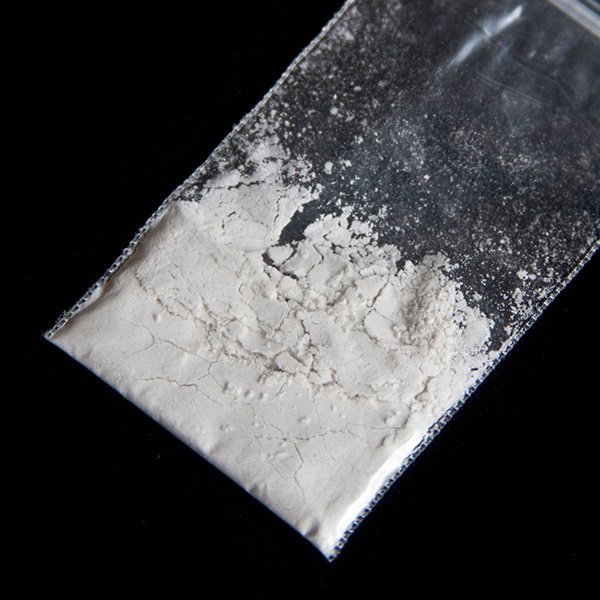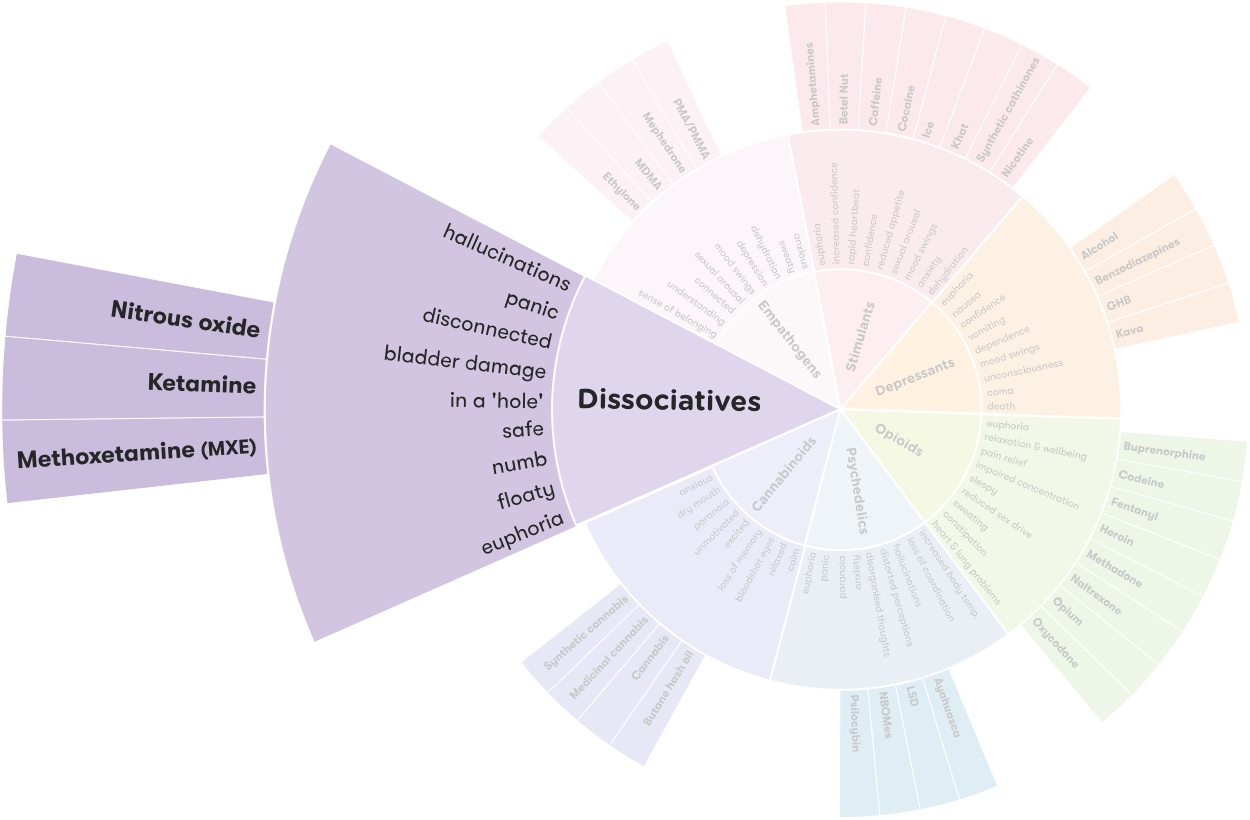Methoxetamine

Last published: November 23, 2023
What is methoxetamine?
Methoxetamine (MXE) is a dissociative drug, which means it causes people to feel separated or detached from their body or physical environment. Dissociatives are similar to psychedelics, they can cause hallucinations and other changes in thoughts, emotions and consciousness.1
MXE may also be known as M-ket, Kmax and Mexxy.4
MXE is also a New Psychoactive Substance (NPS). NPSs are a range of drugs designed to mimic existing illicit drugs. In the case of MXE, it attempts to recreate the effects of ketamine and has been marketed and sold online as a legal alternative. However, in some states and territories, NPSs are illegal.3
MXE is mostly sold as a white, off-white, beige or yellow powder but can also be found in capsule or liquid form. It is often labelled as “Not for Human Consumption” to avoid legal restrictions regarding the importation and sale of illicit drugs and NPSs. All drugs sold in powder form may be sold cut (mixed) with other substances, which can reduce the purity of the dose and have unintended effects. This means that the effects can be unpredictable.4
Other types of dissociatives
How is it used?
MXE is usually snorted, swallowed or injected.2
One of the most significant differences between ketamine and MXE is the length of time before its effects are felt. MXE is said to be slower acting, but more potent and long-lasting. It can take anywhere from 5- 90 minutes to feel the effects. This has led to people overdosing, as they have taken additional doses while waiting for the effect to be felt. When taken orally, the effects are usually felt within 15–45 minutes. After snorting, the effects are reported to occur within a few minutes.5
Effects of Methoxetamine (MXE)
There is no safe level of drug use.
Use of any drug always carries some risk. It’s important to be careful when taking any type of drug.
MXE can affect everyone differently, based on:
- the amount taken
- a person’s height, weight and health
- whether the person is used to taking it
- whether other drugs are taken around the same time
- the strength of the drug (which can vary from batch to batch).
In small doses the following effects may occur and may last for up to 7 hours:
- relaxed and chilled
- euphoria
- empathy
- pleasant sensory experience
- dissociation
- vivid hallucinations
- introspection
- anti-depressant2, 3, 5
Some adverse effects include:
- agitation
- disorientation
- confusion
- dizziness
- anxiety
- rapid heart rate
- nausea
- paranoia
- vomiting
- slurring or difficulty speaking
- psychomotor agitation e.g. tapping or pacing.2, 3
Higher doses or long-term use of MXE can lead to:
- cardiovascular problems
- respiratory damage
- increased risk of injury
- speech difficulties
- memory loss
- panic attacks
- depression.2, 3
As with ketamine, long term use of MXE is also associated with kidney damage and cystitis.2
According to people who have used methoxetamine effects begin in approximately 30 minutes and can last for around 4-6 hours.2
Using methoxetamine with other drugs
The effects of combining drugs – including over-the-counter or prescribed medications – can be unpredictable and dangerous. There is little evidence available on the effects of MXE when combined with other drugs. Anecdotal reports suggest that mixing MXE with alcohol, cannabis and antidepressants should be avoided.2, 6
Reducing harm
- avoid using with other alcohol or other drugs, including over-the-counter or prescribed
- avoid driving or operating heavy machinery
- do not use alone (in case medical assistance is required)
- avoid if you have has a mental health condition
- avoid if you have has an existing heart problem.
Injecting drugs, including MXE, can cause damage to veins and other tissues.
Sharing needles may also transmit:
- Tetanus
- Hepatitis B
- Hepatitis C
- HIV/AIDS.
Dependence and tolerance
There is limited evidence regarding MXE and dependence, however, experts believe that the similarity to ketamine means that it carries a comparable risk of dependence. While the Independent Scientific Committee on Drugs (UK) ranks ketamine as less harmful than other illicit drugs such as methamphetamine, heroin, cocaine or GHB, some studies have indicated a high risk for tolerance and dependence.2, 5, 7
Urinary tract effects
When used repeatedly and for extended periods, MXE seems to show signs of producing similar bladder and urinary tract problems to that of ketamine. Ketamine-induced cystitis can become extremely serious and is a painful condition needing ongoing treatment.2 Anyone suffering from bladder and urinary tract problems needs to stop using MXE and see a health professional.
Coming down/withdrawal:
In the days after MXE use, the following may be experienced:
- • low mood and/or depressive thoughts
- • insomnia
- • memory loss
- • impaired judgement, disorientation
- • clumsiness
- aches and pains.2, 5
More on polydrug use
'Polydrug use' is a term for the use of more than one drug or type of drug at the same time or one after another. Poly drug use can involve both illicit drugs and legal substances, such as alcohol and medications.
Getting help
If your use of MXE is affecting your health, family, relationships, work, school, financial or other life situations, or you’re concerned about a loved one, you can find help and support.
Call the National Alcohol and Other Drug Hotline on 1800 250 015 for free and confidential advice, information and counselling about alcohol and other drugs
Help and Support Services search
Find a service in your local area from our list. Simply add your location or postcode and filter by service type to quickly discover help near you.
If you're looking for other information or support options, send us an email at druginfo@adf.org.au
Path2Help
Not sure what you are looking for? Try our intuitive Path2Help tool and be matched with support information and services tailored to you.
Find out more
- Li L, & Vlisides, P. . Ketamine: 50 Years of Modulating the Mind. Frontiers in Human Neuroscience. 2016;10:1-15.
- Psychonaut Wiki. Methoxetamine 2020
- World Health Organization. Methoxetamine (MXE) Critical Review Report. 2015.
- Bright S. Not for human consumption: new and emerging drugs in Australia. Melbourne Alcohol and Drug Foundation 2013.
- Hartney E. What to Know About MXE Use 2019
- Drug Science. Methoxetamine n.d.
- Morgan C, Noronha, L., Muetzelfeldt, M., Fielding, A. & Curran, V.,. Harms and benefits associated with psychoactive drugs: findings of an international survey of active drug users Journal of Psychopharmacology 2013;27(6):497–506.
Explore dissociatives on the Drug Wheel
